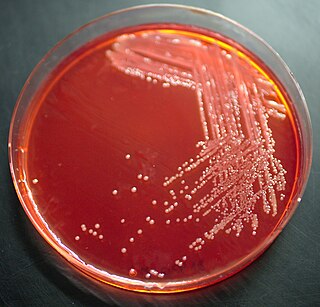
Yersinia is a genus of bacteria in the family Yersiniaceae. Yersinia species are Gram-negative, coccobacilli bacteria, a few micrometers long and fractions of a micrometer in diameter, and are facultative anaerobes. Some members of Yersinia are pathogenic in humans; in particular, Y. pestis is the causative agent of the plague. Rodents are the natural reservoirs of Yersinia; less frequently, other mammals serve as the host. Infection may occur either through blood or in an alimentary fashion, occasionally via consumption of food products contaminated with infected urine or feces.
In biology, quorum sensing or quorum signalling (QS) is the ability to detect and respond to cell population density by gene regulation. As one example, QS enables bacteria to restrict the expression of specific genes to the high cell densities at which the resulting phenotypes will be most beneficial. Many species of bacteria use quorum sensing to coordinate gene expression according to the density of their local population. In a similar fashion, some social insects use quorum sensing to determine where to nest. Quorum sensing may also be useful for cancer cell communications.

Yersinia enterocolitica is a Gram-negative, bacillus-shaped bacterium, belonging to the family Yersiniaceae. It is motile at temperatures of 22–29°C (72–84°F), but becomes nonmotile at normal human body temperature. Y. enterocolitica infection causes the disease yersiniosis, which is an animal-borne disease occurring in humans, as well as in a wide array of animals such as cattle, deer, pigs, and birds. Many of these animals recover from the disease and become carriers; these are potential sources of contagion despite showing no signs of disease. The bacterium infects the host by sticking to its cells using trimeric autotransporter adhesins.

Yersinia pseudotuberculosis is a Gram-negative bacterium that causes Far East scarlet-like fever in humans, who occasionally get infected zoonotically, most often through the food-borne route. Animals are also infected by Y. pseudotuberculosis. The bacterium is urease positive.

Swarming motility is a rapid and coordinated translocation of a bacterial population across solid or semi-solid surfaces, and is an example of bacterial multicellularity and swarm behaviour. Swarming motility was first reported by Jorgen Henrichsen and has been mostly studied in genus Serratia, Salmonella, Aeromonas, Bacillus, Yersinia, Pseudomonas, Proteus, Vibrio and Escherichia.
Yersinia kristensenii is a species of bacteria. It is Gram-negative and its type strain is 105. It is potentially infectious to mice. It secretes a bacteriocin that targets related species.
Yersinia intermedia is a Gram-negative species of bacteria which uses rhamnose, melibiose, and raffinose. Its type strain is strain 3953. It has been found in fish, and contains several biotypes. It is not considered of clinical relevance, being isolated from humans in a routine manner.
Vibrio furnissii is a Gram-negative, rod-shaped bacterium. Its type strain is ATCC 35016. V. furnissii is aerogenic (gas-producing), and uses L-rhamnose, L-arginine, L-arabinose, maltose, and D-mannitol, but not L-lysine, L-ornithine, or lactose. It has been isolated from patients with gastroenteritis, bacteremia, skin lesions, and sepsis.
Thauera aromatica is a species of bacteria. Its type strain is K 172T.
Afipia clevelandensis is a species of the Afipia bacterial genus. It is a gram-negative, oxidase-positive, non-fermentative rod in the alpha-2 subgroup of the class Proteobacteria. It is motile by means of a single flagellum.
Psychrobacter arcticus is a Gram-negative, nonmotile species of bacteria first isolated from Siberian permafrost. Its type strain is 273-4T.
Mannheimia varigena is a bacterium, predominantly encountered in ruminants and historically classified within the former bacterial Pasteurella haemolytica complex, a group of bacteria involved in bovine respiratory disease (BRD). It is pathogenic.
Hydrogenovibrio crunogenus is a colorless, sulfur-oxidizing bacterium first isolated from a deep-sea hydrothermal vent. It is an obligate chemolithoautotrophic sulfur oxidizer and differs from other species of this genus by its DNA base composition and by its growth rate and optimal pH in thiosulfate medium. ATCC 35932T is the type strain of the species. It was originally published in the genus Thiomicrospira as Thiomicrospira crunogena but was reclassified to the genus Hydrogenovibrio in 2017, resulting a grammatical gender change of the specific epithet from crunogena to crunogenus. The genome sequence of H. crunogenus XCL-2 has been published but that of the type strain has not yet been undertaken.
Pasteurella lymphangitidis is a bacterium; it causes bovine lymphangitis. Its reclassification to Yersinia has been proposed, given it poses a 99% sequence similarity to both Yersinia pseudotuberculosis and Yersinia pestis.
Yersinia mollaretii is a Gram-negative species of bacteria. The species is named after Henri Mollaret, the former head of the National Yersinia Center at Institut Pasteur.
Prevotella bryantii, previously known as Bacteroides ruminicola ruminicola subsp. brevis biovar 3, is a species of bacterium.
Methylorubrum zatmanii is a bacterium.
Novosphingobium aromaticivorans is a species of bacteria. It is an aromatic compound-degrading bacteria, it is gram-negative, non-spore-forming, non-motile and rod-shaped. It is found in deep-terrestrial-subsurface sediments.

Yersinia hibernica is a species of Yersinia that was originally isolated in a pig-production environment. The type strain is CFS1934. This species has previously been misidentified as Yersinia enterocolitica and Yersinia kristensenii but it may be distinguished biochemically by lack of sucrose utilization. In addition to pig related environments, Y. hibernica has also been isolated from the feces of Rattus norvegicus and Hydrochoerus hydrochaeris.




